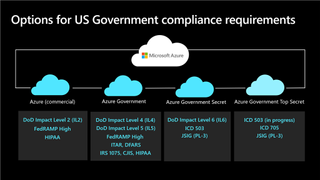Microsoft launches new top-secret cloud platform
Microsoft launches new Azure Government cloud for top-secret classified data

Microsoft is expanding its family of cloud solutions by announcing a new Azure cloud that will better serve US Government customers that work with classified information.
Microsoft Azure Government Top Secret will join the existing roster of clouds available to the US Government, including Azure Government, Azure Government Secret, and the Azure public cloud.
Microsoft has confirmed that it is currently working with the US Government to secure accreditation but has recently completed the buildout of the new Azure Government Top Secret regions. The technology firm has promised that its new classified offering will provide the same level of performance as other government and commercial clouds.
- The best cloud computing services for digital transformation
- The best cloud storage services for your business
- Also, check out our list of the best servers on the market
Top secret
Microsoft Azure Government Top Secret will offer a broad range of services specifically suited to customers working in the classified space. As well as providing greater agility, the new cloud will enable users to gain deeper insights from their data and allow provisions for secure remote working.
In other news relevant to its government customers, Microsoft announced that Windows Virtual Desktop is now available with FedRAMP High accreditation for Azure Government cloud users, as are Availability Zones, which will manage datacenter failures via redundancy and logical isolation of services.

A number of other new features were also announced for Azure users during Microsoft’s annual Government Leaders Summit.
“The consistency between Azure (commercial), Azure Government, and Azure Government Secret is also starting to change the game as software development may happen from anywhere, while the code itself can be promoted to enclaves with higher classification levels,” Carroll Moon, CTO of CloudFit Software, the 2020 winner of the MSUS Partner Award for the Government Industry, explained.
Are you a pro? Subscribe to our newsletter
Sign up to the TechRadar Pro newsletter to get all the top news, opinion, features and guidance your business needs to succeed!
“There it can interact with data of higher classification levels. At the end of the day, this means doing more for the mission at a lower overall cost."
- We've also put together a list of the best cloud hosting providers
Via ZDNet
Barclay has been writing about technology for a decade, starting out as a freelancer with ITProPortal covering everything from London’s start-up scene to comparisons of the best cloud storage services. After that, he spent some time as the managing editor of an online outlet focusing on cloud computing, furthering his interest in virtualization, Big Data, and the Internet of Things.

